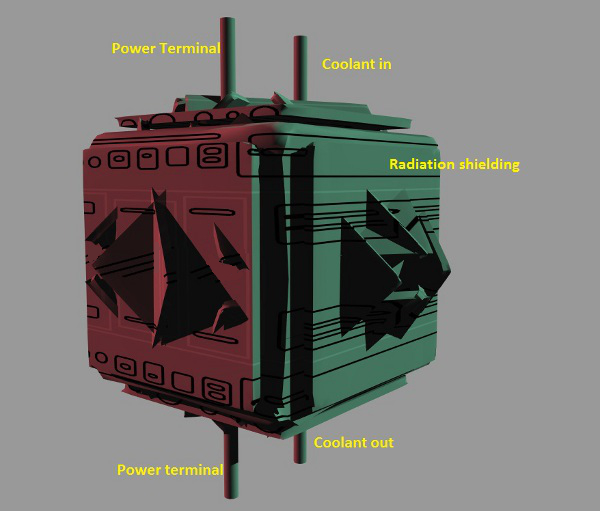BY LETTER
Conversion Micro-Reactor
Technology > Application > Matter Conversion
Technology > Application > Power Generation
Technology > Technology Levels > Ultratech
Technology > Application > Power Generation
Technology > Technology Levels > Ultratech
 Image from Steve Bowers |
Micro-reactors use an electric discharge or high power microwave pulse to initially convert a stock of helium-3 (used to minimize neutron production) into plasma within the reactor's magnetic containment. Magnetic monopoles are then injected into the plasma, converting a portion of it to energy via proton catalysis. Conversion of the helium produces either a pair of high energy protons or a high energy proton and a high energy neutron. The protons heat the helium, maintaining the plasma and creating a hot working fluid that drives a magnetohydrodynamic generator to produce electricity. Radiation shielding is provided by 3-20cm (depending on system design and output) of neutron absorbing material surrounding the reactor core.
Although Helium-3 is the fuel of choice when minimal neutron production is desired, in practice virtually any form of baryonic matter is a potential energy source. Reactors may incorporate small compressors and storage tanks to use the local atmosphere, more robust units for handling liquids, or even systems designed to extract, ingest, and process local dirt and rock into convertible fuel. The most advanced 'hybrid' units can make use of a variety of materials, either by incorporating multiple fuel systems within their structure or by being able to actively reconfigure to accommodate whatever is available. Such systems generally require significantly more shielding due to increased radiation output, and may employ filters or hardened components to protect themselves from exposure to dust, corrosive gases, or other environmental challenges. Many reactors incorporate effector frame technology, allowing them to maintain and repair themselves, attach or remove fuel and cooling lines, or physically move from place to place when required.
The smallest micro-reactors are roughly 40x40x30cm in their major dimensions (not including support structure, fuel, shielding, and cooling systems) and can produce 1-20kw of electricity for anything up to several centuries, depending on design and available fuel. They may be used to power individual homes, operations in remote locations away from standard power grids, large vecs and bots, aircraft, and small spacecraft or orbital installations. They are also commonly used as back-up and emergency power supplies in a variety of applications. Larger reactors may scale up to the size of a medium sized ground vehicle before passing out of the 'micro' classification, but standards vary from polity to polity.
Related Articles
Appears in Topics
Development Notes
Text by Luke Campbell and Todd Drashner
Ryan B, Mike Miller, and Ian Campbell
Initially published on 05 May 2016.
Ryan B, Mike Miller, and Ian Campbell
Initially published on 05 May 2016.






